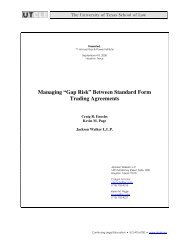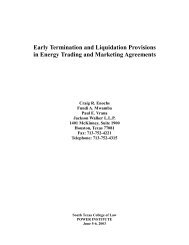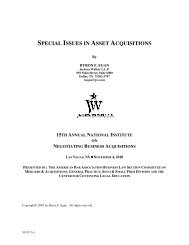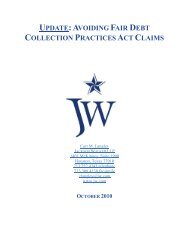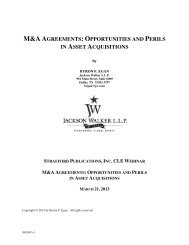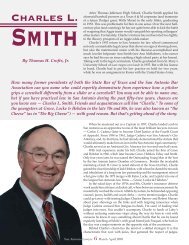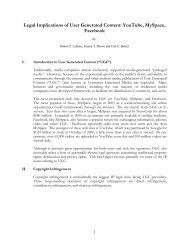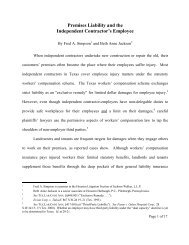asset acquisitions - Jackson Walker LLP
asset acquisitions - Jackson Walker LLP
asset acquisitions - Jackson Walker LLP
You also want an ePaper? Increase the reach of your titles
YUMPU automatically turns print PDFs into web optimized ePapers that Google loves.
clause (iv) of Section 3.2(b), the Seller’s counsel should consider sales and transfer taxes.See the Comment to Section 10.2.The purpose served by the no conflict representation differs from that served by themore general representations concerning Legal Requirements, Governmental Authorizations,Orders, and Contracts (see Sections 3.17, 3.18 and 3.20), which alert the Buyer to violationsand other potential problems not connected with the acquisition. The no conflictrepresentation focuses specifically on violations and other potential problems that would betriggered by the consummation of the acquisition and related transactions.The term “Contemplated Transactions” is defined broadly in Article 1. The use ofan expansive definition makes the scope of the no conflict representation very broad. Aseller may argue for a narrower definition and may also seek to clarify that the no conflictrepresentation does not extend to laws, contracts, or other requirements that are adopted orotherwise take effect after the closing date. In addition, the seller may seek to clarify that theno conflict representation applies only to violations arising from the seller’s and theshareholders’ performance of the acquisition and related transactions (and not to violationsarising from actions taken by the buyer).The no conflict representation relates both to requirements binding upon the Sellerand to requirements binding upon the Shareholders. (Requirements binding upon the Buyerare separately covered by the Buyer’s “no conflict” representation in Section 4.2 and theclosing condition in Section 8.1.) The Shareholders may seek to eliminate the references tolaws, regulations, orders, and contracts binding upon the Shareholders, arguing thatviolations of requirements applicable only to the Shareholders (and not also applicable to theSeller) should be of no concern to the Buyer because the Buyer is not making an investmentin the Shareholders. The Buyer may respond to such an argument by pointing out that aviolation of a law, regulation, order, or contract binding upon the Shareholders can be ofsubstantial concern to the Buyer if such a violation would provide a governmental body or athird party with grounds to set aside or challenge the acquisition. The Buyer may also pointout that, if the Shareholders were to incur a significant financial liability as a result of such aviolation, the Shareholders’ ability to satisfy their indemnification obligations and otherpost-closing obligations to the Buyer could be impaired.The phrase “with or without notice or lapse of time,” which appears in theintroduction to the “no conflict” representation, requires the Seller to advise the Buyer of any“potential” or “unmatured” violations or defaults (circumstances that, while not technicallyconstituting a violation or default, could become an actual violation or default if a specifiedgrace period elapses or if a formal notice of violation or default is delivered) that may becaused by the acquisition or related transactions.Clause (ii) of the “no conflict” representation focuses specifically on LegalRequirements and Orders that might be contravened by the acquisition or relatedtransactions. The broad language of this provision requires disclosure not only of legalviolations, but also of other types of adverse legal consequences that may be triggered by theContemplated Transactions. For example, the “Exon-Florio” regulations, 31 C.F.R. §800.101 et seq., provide for the submission of notices to the Committee on ForeignInvestment in the United States in connection with <strong>acquisitions</strong> of U.S. companies by“foreign persons.” Because the filing of an “Exon-Florio” notice is voluntary, the failure tofile such a notice is not a regulatory violation. However, the filing of such a notice shortensthe time period within which the President can exercise divestment authority and certain3148166v1- 74 -




